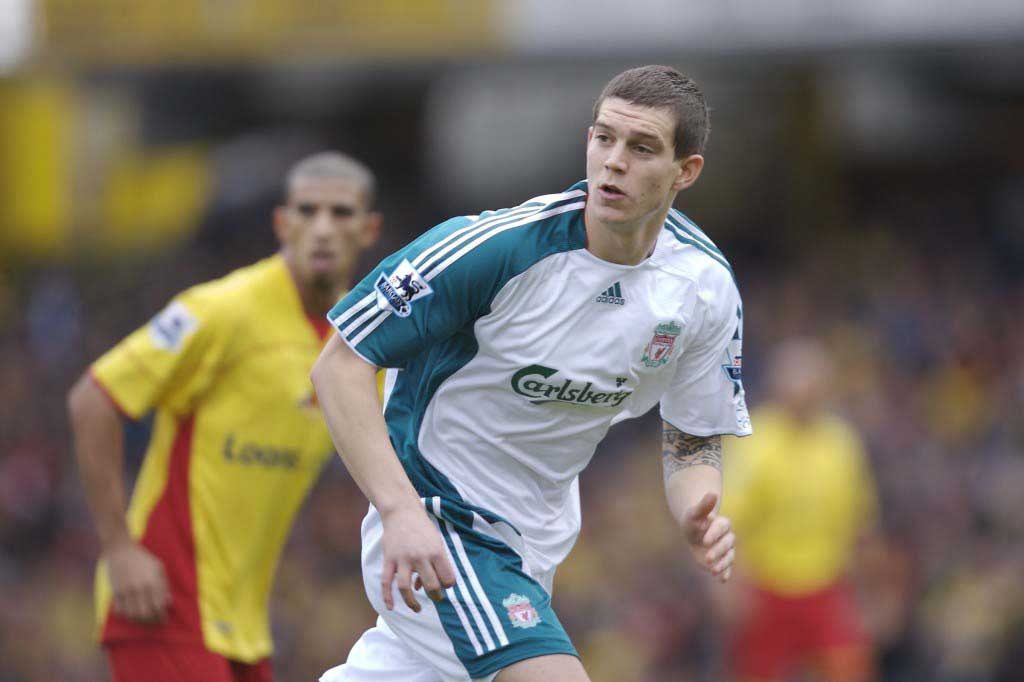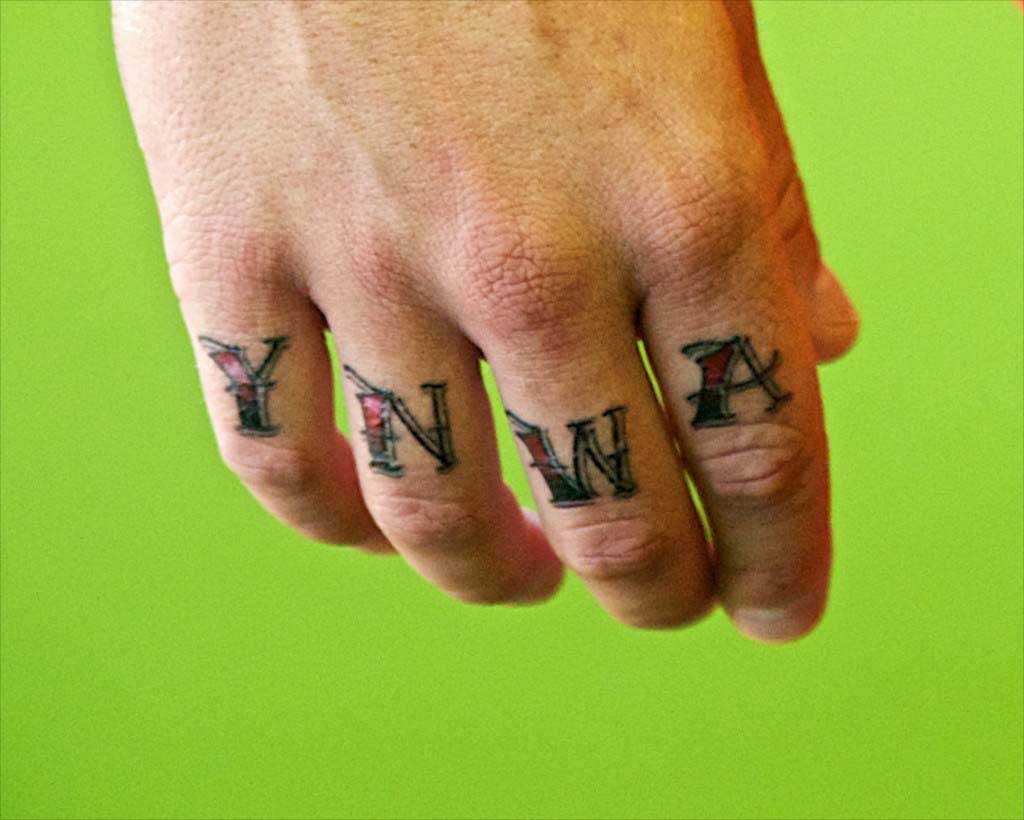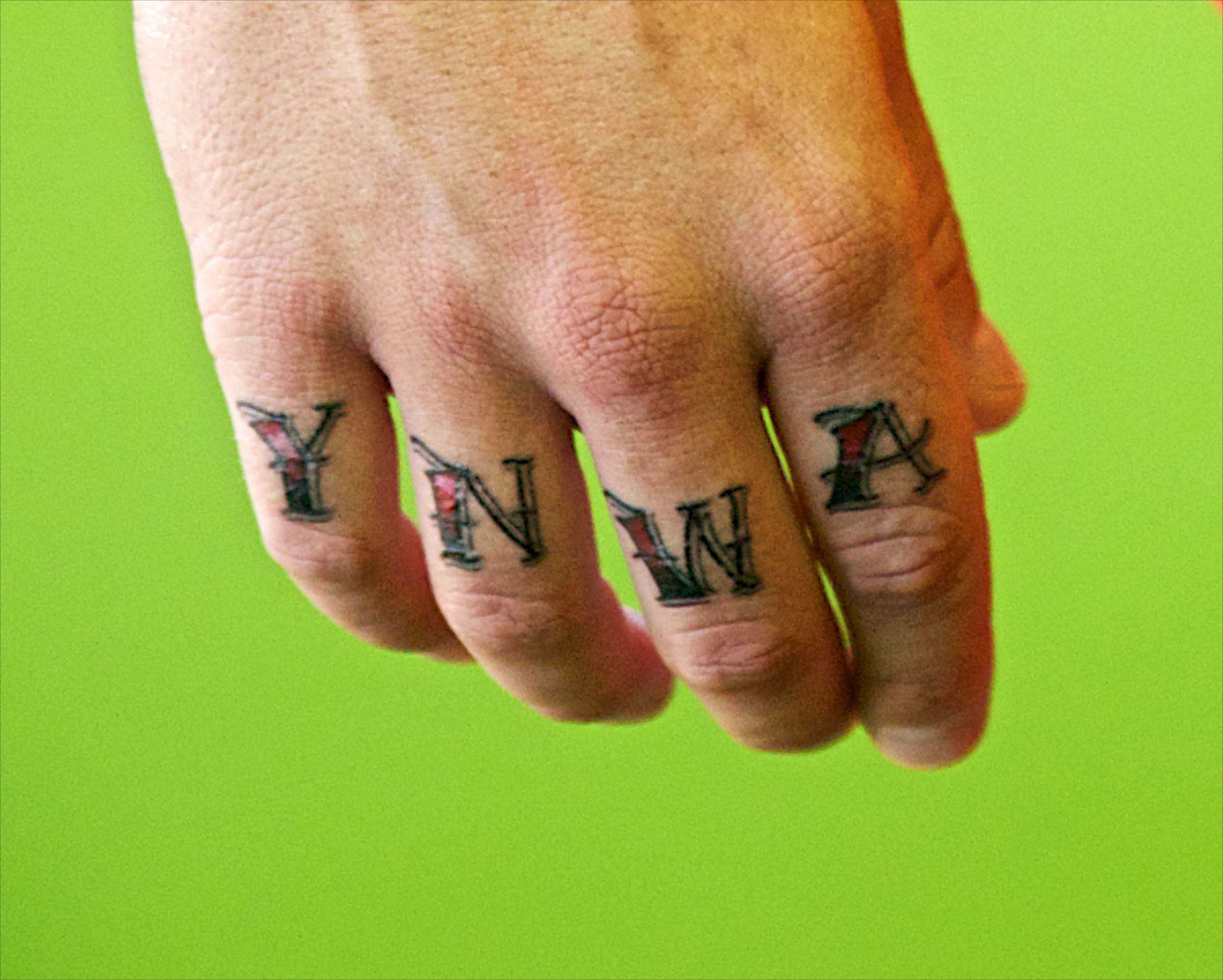WATCH it. It was a thing of beauty. Eight years ago last week, a young Liverpool centre-back strode forward from the centre circle. Taking a couple of touches, the pitch opened out in front of him. The opposition stood off, beckoning him forwards. There was nothing else to be done – have a hit son.
With a savage swish of his left boot, the ball swerved serenely towards the top left-hand corner. It couldn’t have gone further into the corner. The net bulged. The keeper motionless. The young centre-back peeled away, arms aloft. Nonchalant.
After a stop-start first six months this was some way to announce yourself as the long-term successor to Sami Hyypia. Such a shame then, that Daniel Agger’s Anfield career ended as it did: a return from whence he came, to little fanfare, without a richly deserved farewell send-off.
To talk of Agger’s eight-and-a-half year stay at Anfield is to enter a world of unfulfilment. Here was a defender with unflappable elegance and muscular build; surely an unbeatable combination in a centre-back? But to go with these attributes, a body that was so susceptible to injury that it restricted him to 232 appearances (as @BassTunedToRed tweeted over the weekend, only 51% of Liverpool’s games since his debut in February 2006).
Agger’s Anfield career started slowly, before flourishing, stagnating, floundering, enjoying an overdue renaissance and petering out as it has over the past 12 months.
The Dane chalked up 43 appearances in his first full-season, 2006-7, relegating Sami Hyypia to the bench. He looked ready made, the future of Liverpool’s defence playing week in, week out at the age of 22/23. Centre-back is the hardest position for a youngster to fill, let alone if you’re seeking to displace a club legend in the process. The season was bookmarked by big goals; the 25-yard screamer against West Ham – you see loads of 25-yard screamers in football, but this is one of the better ones – and the Champions League semi-final goal against Chelsea.
But did he ever truly kick on, and was that really his fault? Tragically the 43 appearances made in that season have remained a career high to this day.

In September 2007 his first major injury struck, and he was rarely the same again. Rarely a permanent fixture, rarely niggle free. He played six times before injuring his metatarsal during a Champions League trip to FC Porto, and didn’t feature again for a year. Martin Skrtel joined, Sami Hyypia kept on going, and Agger struggled to re-assert himself throughout 2008-9.
There was little that could be done to prevent the slide of 2009-10, but it was the season after where Agger’s ability was fully understood – in absentia.
He was held up to almost messianic status during the abysmal days of Roy Hodgson, continually overlooked for the more agricultural qualities of Sotirios Kyrgiakos. “I’m here to play, not to unload”, he reportedly told Danish TV in September 2010, while Hodgson barked at him “to f***ing get rid.”
He was the symbol, along with Glen Johnson at the time, of what had been lost at Liverpool under Hodgson. The ostracisation of those who would keep the ball, who would play it out from the back, venture past the half-way line, was as damaging to the club as the poor results, and symptomatic of the dreadful style of football churned out.
Under Dalglish came the renaissance. He was restored straight into the side for the FA Cup third round tie at Old Trafford in early 2011, having figured only twice in four months.
Weeks later came one of his most iconic moments in a red shirt, on Fernando Torres’ Chelsea debut, when he whacked the Spaniard in theface. Showing not an ounce of remorse, the Dane jogged back into position while Torres writhed on the floor in faux-agony.
Agger later reflected on Torres’ departure, hinting at the disdain that that incident illustrated:
“It’s unacceptable to play for one of Liverpool’s arch rivals. It’s about having respect for the club you play at. I’m proud to be able to pull on my Liverpool jersey and will never go to another club in England.”
During Dalglish’s reign Liverpool only conceded a goal every 135 minutes with Agger in the side. His partnership with Martin Skrtel genuinely blossomed, for a time, and another club legend at centre-back lost his place. For the first time in five years, his regular place in the starting 11 was guaranteed. The Skrtel-Agger axis had been a tantalising prospect since the Slovak’s arrival in 2008, but it had taken almost four years for it to become a reality.
Yet, much like Agger’s Liverpool career, that consistency didn’t last long. Injuries kept coming, he struggled to string a long-run of games together and the side always looked weaker without him, though that is largely because the alternative – Carragher-Skrtel – barely functioned.
But it remains peculiar that when at the height of his powers, between the summers of 2012 and 2013, the Dane continually rejected the notion of leaving Anfield. This was of course not the club he had joined back in 2006, challenging for major honours and continually delving deep into European competition.
Champions Manchester City came calling in 2012, Barcelona a summer later. Both times the club appeared willing to sell, yet both times Agger refused.
Many Liverpool fans admire Agger for his unstinting loyalty, especially when during a summer of intense speculation surrounding his future in 2012 he had “Y.N.W.A” tattooed on to his knuckles.
“I’m proud to be here and my knuckles show that.”

This was a mess of a club with high turnover of players and management, with seemingly no end in sight to the monotony of sixth-seventh-eighth placed finishes.
His farewell letter to Liverpool fans suggests he does not regret rejecting these glamorous overtures, that he does not regret what will now be remembered as a career unfulfilled.
“The opportunity arose for me to return home to Brondby and at this stage of my career it felt like the right decision for me.
“I wouldn’t leave here to go anywhere else and that has been proven by my actions in recent seasons – I have turned down many offers to move to other Premier League and European clubs.
It’s no great surprise that after years of rejecting the opportunity to play Champions League football, to challenge for major trophies at clubs far better equipped for it, that he has traded the home comforts of Merseyside for his boyhood club Brondby.
It is a great shame that his ambition never truly matched his talent.
He will be remembered as one of Liverpool’s most stylish centre-backs – we’re not simply talking about the tattoos here – but not as one of the greatest. The cult of Agger – the great Dane at the heart of Liverpool’s defence – is his greatest legacy, but it is a myth.
Too often was Agger found lightweight, too often bullied by centre-forwards, not only the big ones. Didier Drogba ran him ragged on a number of occasions, particularly in the Champions League semi-final at Stamford Bridge in 2007.
That lack of consistency was his biggest flaw; in the same game he could look imperious, before switching off and completely losing his man. In short, he could be guilty of being too passive.
But he was good on the ball? He had a good shot on him? Perhaps the memories of blockbuster strikes against West Ham and Blackburn, and the occasional marauding run upfield early in his career, clouded people’s judgements.
His loyalty was among his greatest strengths according to some Liverpool fans; an admirable, but ultimately naive loyalty. Why would someone touted as among the best centre-backs in Europe – rightly or wrongly – not want to test themselves at a higher level at their peak? He coasted for too long, before the arrival of Mamadou Sakho 12 months ago.
He claims that this is the right move at the right time for him. That is probably fair, but to be saying that of a 29-year old not long ago regarded as among the best in Europe in his position, is a crying shame – the word’s been used multiple times already, but it is the most apt. He should be at his peak, not slinking off back to Denmark; five years have been shaved off his career:
“More recently I have started to feel the effects of playing regularly in a league that is as physically demanding as the Premier League is, and I would not want to stay if I did not think that I was able to meet that challenge week in, week out.”
For all the faults though, it is hard to hold anything against him. He may not have been as formidable a player as some seem to believe, and the injuries robbed of him what could have been a stellar career, but his connection with the fans and the club was very real. Alongside Pepe Reina and Dirk Kuyt he is a true adopted Scouser. It just should have ended differently.
Pictures: David Rawcliffe












He should also be remembered for having the decency and the guts to speak out about the shambles we were under Hodgson. The only player to do so openly at the time. http://www.theguardian.com/football/2010/sep/20/daniel-agger-roy-hodgson-liverpool
A nice, finely-balanced article that summarises the great Dane’s strengths and weaknesses.
I think Rodgers decided he’d had enough with the way the established back 4/5 were playing after his first season in charge. They’d all got too complacent. Agger and Skrtel *look* like the perfect centre-back duo both physically and in attributes but they were so brittle at times. It spoke volumes that Carra was brought back as a regular starter to add defensive solidity. Reina is a total trouper but he’d had a couple of iffy seasons by the time he was eased out.
It’s interesting how Rodgers has disposed of Reina, Agger and Kuyt with little fanfare and more than a little ruthlessness, especially given their standings as fan favourites. I suppose if you have a plan and it works out, you will be forgiven.
I don’t get the critique, James. On the one hand, you aptly document the fact that he was injury-prone. On the other, you question his lack of ambition and willingness to shave years off his career by going back to Brondby. The man himself cited injury concerns as his reason for leaving.
Yeah maybe that wasn’t clear, just saying that it’s a shame he didn’t move on when he could have done something more with his career, like a couple of years ago. Ordinarily a 29-year old would be at his peak not leaving for a minor European league, even if it is “home”, so it’s a shame that injuries have done this to him.
Shame he didn’t move on to another club at the peak of his ability? What kind of Liverpool fan are you?
His body may not have been up to it, but what heart.
I’ll miss the guy. He bled Red.
Good summary of his Liverpool career, and while accurate – maybe should place a little more emphasis on the fact that despite injuries – for most of the time he was at the club – he was our best CB option, and if he’d left either season Barca were making overtures – he’d have been incredibly difficult to replace.
Loyalty. Cheers Dagger.
Now does that mean Caroline Wozniacki won’t be a “fan” of LFC anymore?
I get your point (I think) but in light of his statements both about loyalty and injury, I found this article a bit mean-spirited. It’s probably too soon to be this coldly objective. Right now I think Daniel deserves our thanks and respect. If we hate Torres for showing the same ambition you’re saying Daniel lacked, then maybe that’s a cause to love him. I know I do.
Completely agree. The only feeling I have towards Agger right now is affection. Over and above all he wanted, and loved, playing for Liverpool. That should be enough to wish him well but he was also a class act on his day. His inconsistency and injuries aside he was still in the top 2/3 CBs for the past 8 years. YNWA Agger. Hope we play Brondby again.
Summed it up very well. Maybe the perceived lack of ambition stemmed from the simple fact that he put personal happiness in his environment ahead of medals and trophies? He felt at home with us and then returned home. Can’t really fault the man for that.
You hit the highlights of the man but your critique I find overly harsh. He did the best he could (which was often excellent but not always) with the tools he had AND more than anyone other than Stevie or Carra he knew what it meant to play for Liverpool. I remember when he could have gone to Barca, Arsenal or City in the dark days and nobody would have begrudged him but it would have been such a psychological blow. That he stayed was huge. He stayed because WE needed him to. He could have gone to better football, more money, trophies beyond one league cup.
That clip of his forearm smash on Torres and the quote about not playing for rivals – based on those alone he’s got a free pass for life from me.
He was a good player and a great servant. We were lucky to have him.
Would be nice to see a post-season friendly with Bronby as Anfield, like LFC did in Dublin last season. For someone who was obviously a great member of the club, and who showed loyalty that is all too rare in this day in age, it would be the right thing to do for give him some type of send off. I bet it would mean the world to him too
Brondby*
This is a bit of a peculiar angle: he was great when he played, but didn’t play regularly enough, but then when he was playing consistently well, he should have left? Eh? Surely he should be lauded for playing well, not seeking to move, and unlike 99% of other contemporary footballers, placing his relationship with his club (and presumably his personal happiness) above ‘personal ambition’.
The classiest central half we’ve had since Hansen, a loyal servant, and by the looks of it, a pretty cool bloke. He’ll be remembered for all the right reasons and if there are any regrets, it’s simply that he was too injury prone. No shame in that.
some decent points James, but the whole article assumes that Agger has the same set of values as the modern day footballer – which he doesn’t. what makes Agger mythical in status IS “the great shame.” Agger cares more about family (both blood and football) than money. He measures success in intangibles like loyalty & courage. no other player has embodied the LFC ethos more (sans Stevie G). Is it a shame that he didn’t go on and do well at one of the Elite clubs?? i think we fans care more about that than he does. it is a shame for LFC from a financial perspective. we could have stood to made up to 20M, but we owed it to Daniel to take the financial hit and let him go back to Brondby. the only other place he’d call home.
Impossible not to love the guy, the Great Dane. He’s the kind of person you need in your life – friend, father, son, barman, whatever position he would be fantastic.
But the niggling injuries meant that he couldn’t be a constant for BR who is after a few qualities including pretty constant availability for that defence.
That meant that he had to accept not playing often when fit – more so now there is Brendan’s Lovren child and Sakho there (incidentally I think Sakho’s niggles count against him too in BR’s eyes). And he wasn’t prepared to do that, especially as the club had entertained offers for him too.
For him that meant his time was up and he needed to go to something else and also he had to believe in that something else, hence Brondby. It’s an incredibly sad story for us because he pulls the heart strings like you just wouldn’t believe.
You just have to wish him well and he does at least have a long long playing career left infront of him playing in a lesser league, with his national role as Captain to enjoy too. You know he will be happy and you have to celebrate that.
YNWA Dagger!
no way would he go to another CL club if he thought his injuries through a punishing schedule would just leave him on the bench or injury table either. That’s why he didn’t do it.
He wouldn’t beable believe in it knowing his limitations.